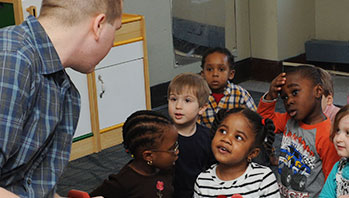- chart paper
- marker
- pictures: ramp, a slide, objects moving on a slide/ramp
- down
- move
- ramp
- roll
- slant
- slide (n., v.)
MA Standards:
Speaking and Listening/SL.PK.MA.1: Participate in collaborative conversations with diverse partners during daily routines and play.
Language/L.PK.MA.1: Demonstrate use of oral language in informal everyday activities.
MA Draft Standards:
Physical Sciences/Motion and Stability; Forces and Interaction/PS2.A: Plan and carry out investigations of the behaviors of moving things.
Physical Sciences/Motion and Stability; Forces and Interaction /PS2.B: Using evidence, discuss ideas about what is making something move the way it does and how some movements can be controlled. [Cause and Effect, Stability and Change]
Head Start Outcomes:
Language Development/Receptive Language: Attends to language during conversations, songs, stories, or other learning experiences.
Language Development/Expressive Language: Uses language to express ideas and needs.
Social Emotional Development/Self-Concept and Self-Efficacy: Identifies personal characteristics, preferences, thoughts, and feelings.
PreK Learning Guidelines:
English Language Arts/Language 2: Participate actively in discussions, listen to the ideas of others, and ask and answer relevant questions.
Science and Technology/Physical Sciences 21: Explore and describe various actions that can change an object’s motion such as pulling, pushing, twisting, rolling, and throwing.
Talk Together: Introduce Ramps

© Commonwealth of Massachusetts, Department of Early Education and Care (Jennifer Waddell photographer). All rights reserved.
STEM Key Concepts: A ramp, or inclined plane, is a surface with one end higher than the other; An object placed on an inclined plane will roll, slide, or stay put
ELA Focus Skills: Concepts of Print, Speaking and Listening, Vocabulary
Place a small block on a piece of cardboard on the floor. Ask, How can we get the block to move? Let children demonstrate and describe their ideas. (Sam pushed the block. Aisha shoved the block with her foot.)
Now ask children how they might move the block without touching it with their bodies. If a child doesn’t introduce the idea of slanting the piece of cardboard, point to a picture showing the incline of a slide and have children think about how things rolled down it.
- Reinforce that a slide is a type of ramp.
- Then slant the cardboard slowly until the block starts to move.
- Tell children that, like the slide, the ramp has a slanted surface and, when objects are placed on a slanted surface, they might roll or slide down it, or they might stay put.
Create an “All About Ramps” chart with children. Include pictures, drawings, and ideas about ramps, for example,
- It has a flat surface
- One end is higher than the other end
- It has a slanted surface
- Some things move down the slide
- Different objects move differently down the slide
Social Emotional Tip: Provide opportunities for children to understand how their actions and thoughts can affect others. For example, writing charts together helps children develop their understanding of group dynamics and expectations.
